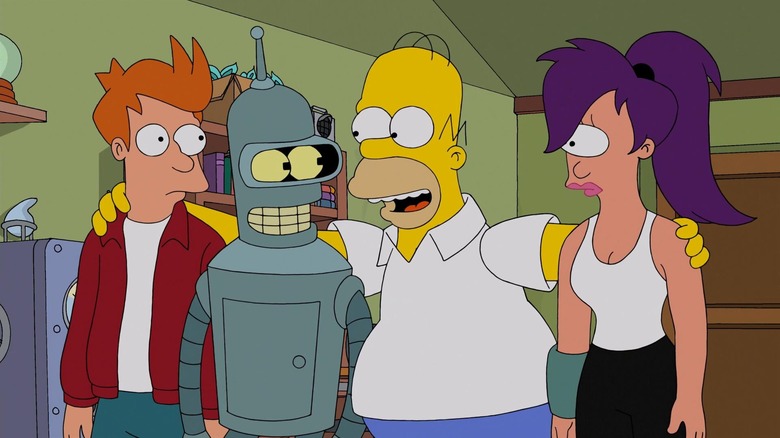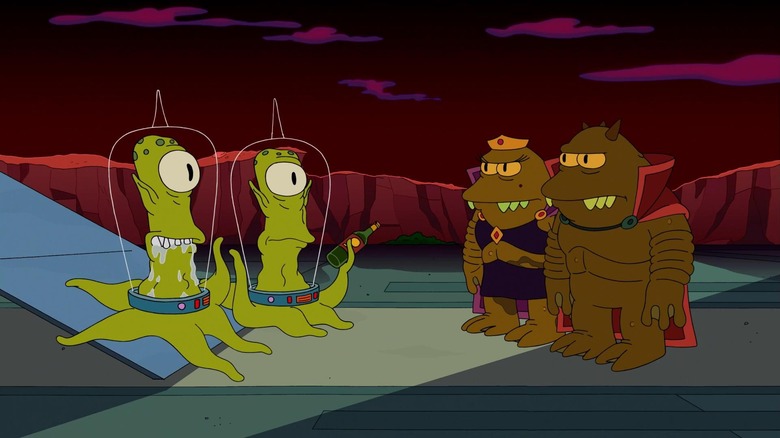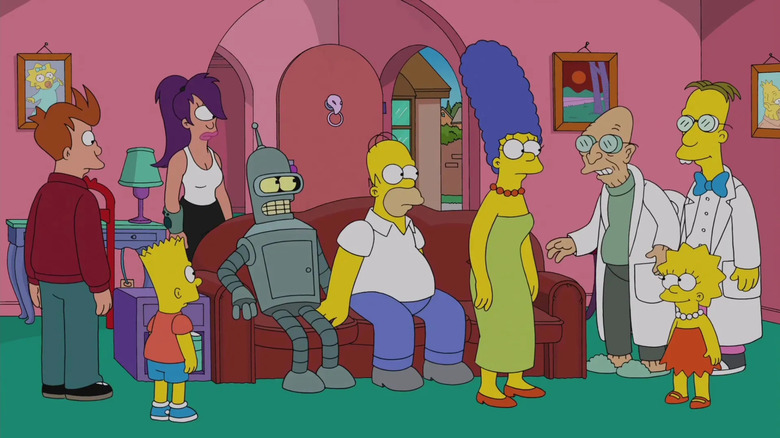The Secret Weapon That Sets Futurama's Animation Apart From The Simpsons
In the "Futurama" episode "A Big Piece of Garbage" (May 11, 1999), Fry (Billy West), Bender (John DiMaggio), and the rest of the Planet Express crew traveled into space to encounter a moon-sized ball of garbage that had been expelled from Earth many centuries before. Among the heaps of trash on the garbage moon, they find a pile of discarded Bart Simpson toys. Bender eats its shorts. The existence of "Simpsons" merchandise in "Futurama" gave the series a pretty bold stance. As the show's co-creator, David X. Cohen said on a DVD commentary track, "The Simpsons" is fiction, while "Futurama" takes place in the real world.
This notion, however, was challenged by a 2014 "Simpsons"/"Futurama" crossover episode called "Simpsorama," wherein Bender went back in time to murder one of the Simpsons, as one of the family's DNA had evolved to create a species of killer rabbit monsters — monsters that would attack the planet — a millennium hence. It seems that, with that amount of causality intact, the world of "Futurama" was indeed set a millennium after "The Simpsons" in the same universe. I'm sure, if asked, Cohen and animation legend Matt Groening would likely say that they don't much care for that kind of stringent inter-series continuity. They just wanted a yuk-fest where Bender and Homer (Dan Castellaneta) drank beer together.
Looking at each show individually, of course, one finds two strikingly different shows. The character design is all based on Groening's style and ideas, but the color scheme is massively different (The Simpsons are yellow, after all, while the non-alien "Futurama" folks are flesh-toned), and the animation is far more ambitious on the sci-fi show. The advanced animation on "Futurama" was discussed by the show's writers and producers in a recent interview with the Daily Beast.
2(and a half)D animation
In the early days of "The Simpsons," the show abided by the old-fashioned, hand-drawn, ink-and-paint style of cel animation that still makes up the bulk of animation history. That has changed in recent years, but for a long time, "The Simpsons" was held up as the last bastion of high-quality TV cel animation. At least that was the story told by this author's animation professors in college back in the late 1990s. In contrast, "Futurama" incorporated more varied techniques, rendering a lot of buildings, exteriors, and spacecraft in CGI ... but CGI that was colored and textured to look like a 2D drawing. At the time, we called it 2½-D. The characters, meanwhile, were still hand-drawn.
Producer Claudia Katz noted that this hybrid look helped "Futurama" stand apart from both "The Simpsons" and its other animated contemporaries. She said:
"In addition to having great voice acting, jokes, and storytelling, we really had to deliver on the sci-fi elements and the only way to do that was with a 2D-3D hybrid animation. [...] We love a challenge, and it was a great opportunity to try and figure that out."
And figure it out they did. Peter Avanzino, the head of Rough Draft Studios, noted that the original mandate was to only use CGI for spacecraft, but that the showrunners dropped that mandate quickly. Soon, CGI was approved for many things. He said:
"We started out just using it on the ship, but by [episode 2], we had this big reaper machine come in and actually pick Bender up. [...] We were constantly figuring out what else we could do with it. Can we use it to close a door? Can we use it for a crowd?"
Yes, they can. And they did.
Put On Your 3D Glasses ... Now
While "The Simpsons" did eventually begin using digital techniques in production, the unique, smooth 2½-D animation was reserved for "Futurama." Indeed, it was the clever use of CGI that would come to be the show's central aesthetic. And, given that it was a sci-fi show, the artificiality was a boon. If a massive robot or spacecraft moved more smoothly than the earthbound characters (or Omicron Persei-8-bound characters), it make logical sense. Avanzino pointed out that they started with ships, expanded to crowds, and now use a lot of CGI many placed throughout the series:
"There's a small section of things that it helps with but it's bigger than you think, and I really like how we've expanded what we can use it for, alongside ships."
So if there's an alien made of glowing gases, CGI is the way to go. When Richard Nixon's severed head is wired into the body of a massive battle bot, CGI works well. If a space portal or colossal negative space wedgie appears in the heavens, best go to the computers. When one of Kif's relatives explodes into a swarm of flying hookworms, get those vermin in 3D. When Fry belches, however, or when Dr. Zoidberg sprays ink on someone, leave that to the many, many talented hand animators who work on the show. Some things require a humane, personal touch.
"Futurama" was revived in 2023, and it has lost none of its aesthetic verve or visual creativity. Likely because of their mandate with CGI.


